Cost Allocation, Overhead, and Inventory Analysis - Finance
VerifiedAdded on 2022/09/17
|9
|599
|13
Homework Assignment
AI Summary
This assignment delves into various cost accounting methods, providing a comprehensive analysis of cost allocation, overhead application, and inventory valuation. The solution begins by explaining the direct, step-down, and reciprocal cost allocation methods. It proceeds to calculate and analyze o...
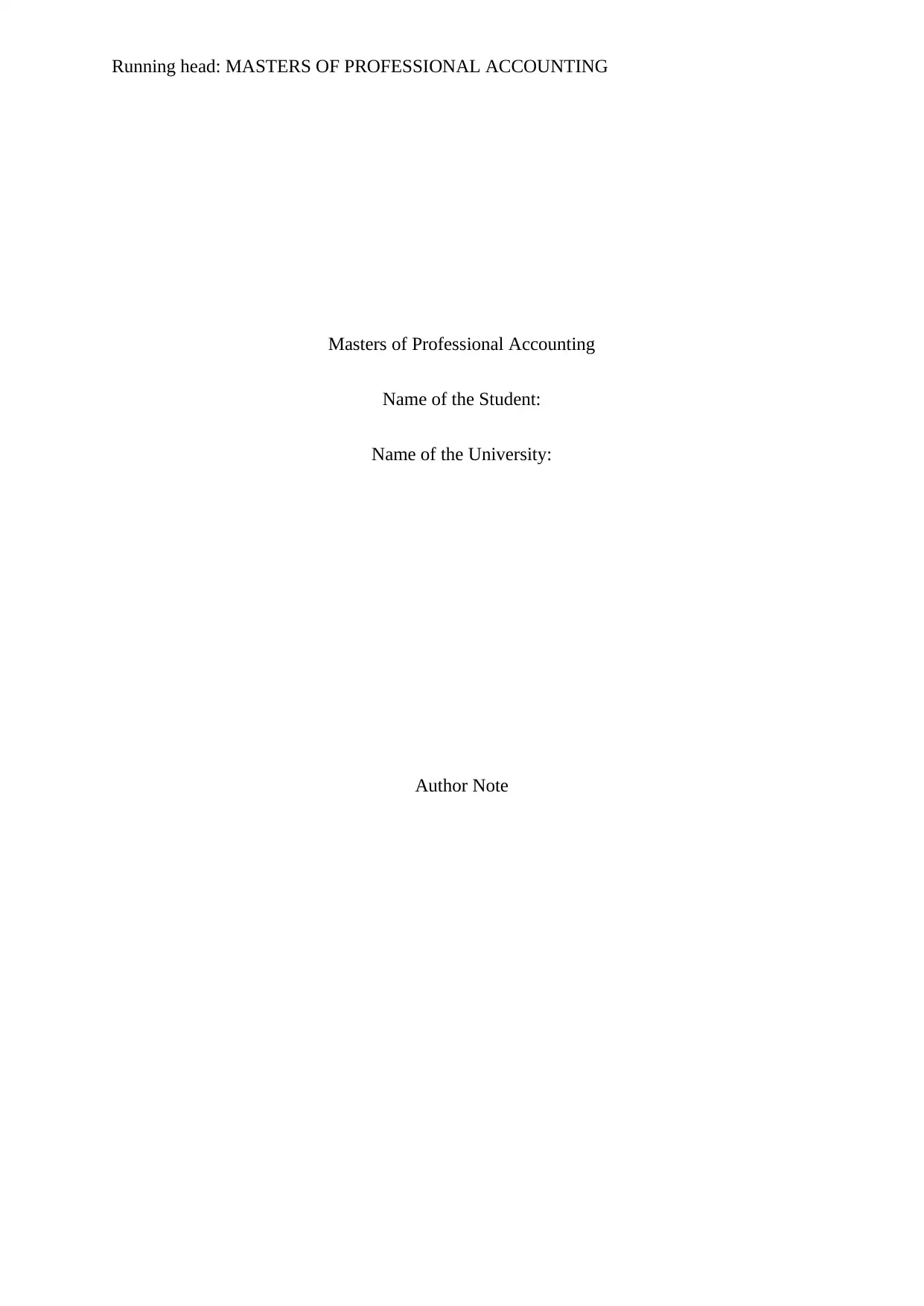
Running head: MASTERS OF PROFESSIONAL ACCOUNTING
Masters of Professional Accounting
Name of the Student:
Name of the University:
Author Note
Masters of Professional Accounting
Name of the Student:
Name of the University:
Author Note
Paraphrase This Document
Need a fresh take? Get an instant paraphrase of this document with our AI Paraphraser
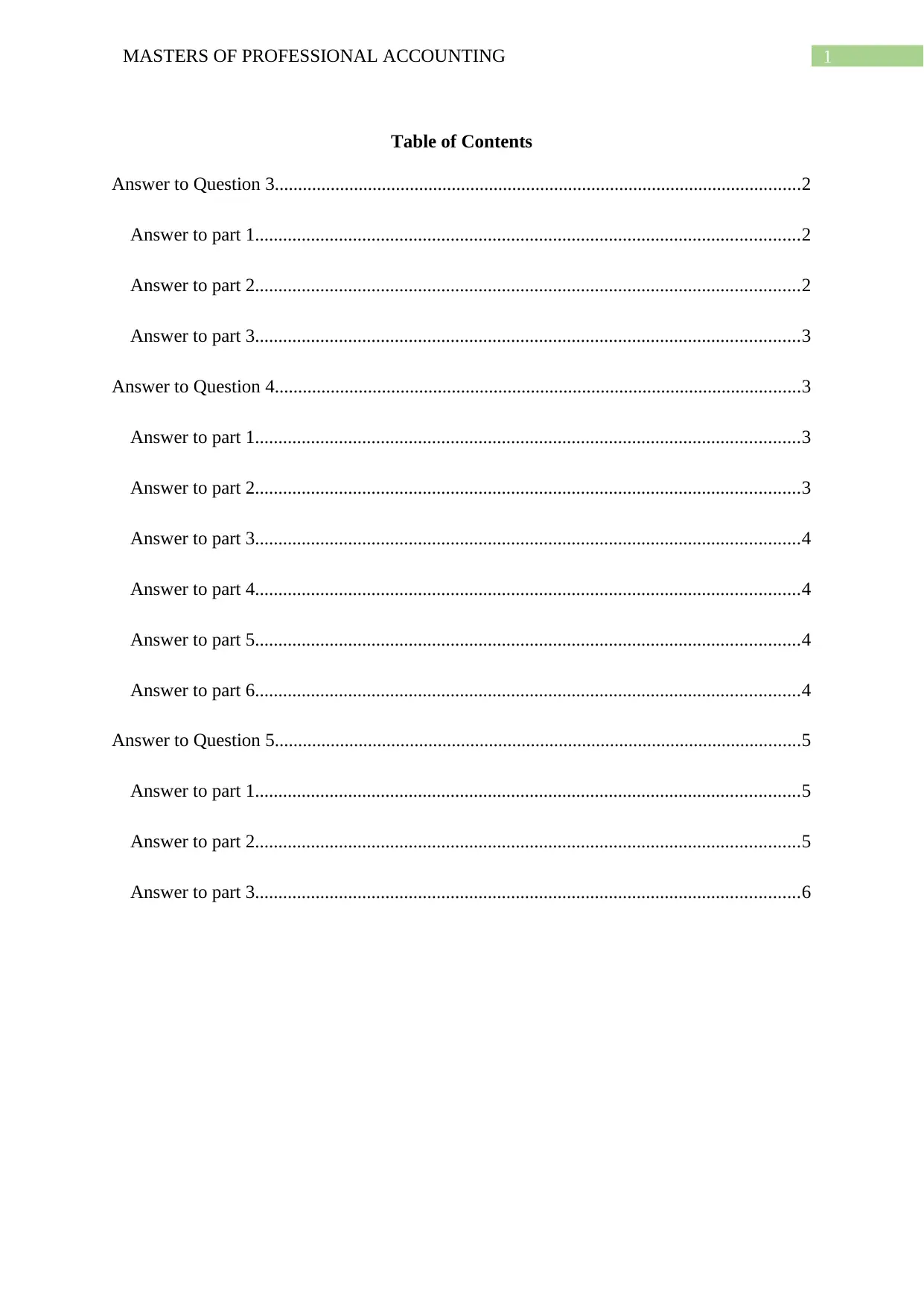
1MASTERS OF PROFESSIONAL ACCOUNTING
Table of Contents
Answer to Question 3.................................................................................................................2
Answer to part 1.....................................................................................................................2
Answer to part 2.....................................................................................................................2
Answer to part 3.....................................................................................................................3
Answer to Question 4.................................................................................................................3
Answer to part 1.....................................................................................................................3
Answer to part 2.....................................................................................................................3
Answer to part 3.....................................................................................................................4
Answer to part 4.....................................................................................................................4
Answer to part 5.....................................................................................................................4
Answer to part 6.....................................................................................................................4
Answer to Question 5.................................................................................................................5
Answer to part 1.....................................................................................................................5
Answer to part 2.....................................................................................................................5
Answer to part 3.....................................................................................................................6
Table of Contents
Answer to Question 3.................................................................................................................2
Answer to part 1.....................................................................................................................2
Answer to part 2.....................................................................................................................2
Answer to part 3.....................................................................................................................3
Answer to Question 4.................................................................................................................3
Answer to part 1.....................................................................................................................3
Answer to part 2.....................................................................................................................3
Answer to part 3.....................................................................................................................4
Answer to part 4.....................................................................................................................4
Answer to part 5.....................................................................................................................4
Answer to part 6.....................................................................................................................4
Answer to Question 5.................................................................................................................5
Answer to part 1.....................................................................................................................5
Answer to part 2.....................................................................................................................5
Answer to part 3.....................................................................................................................6
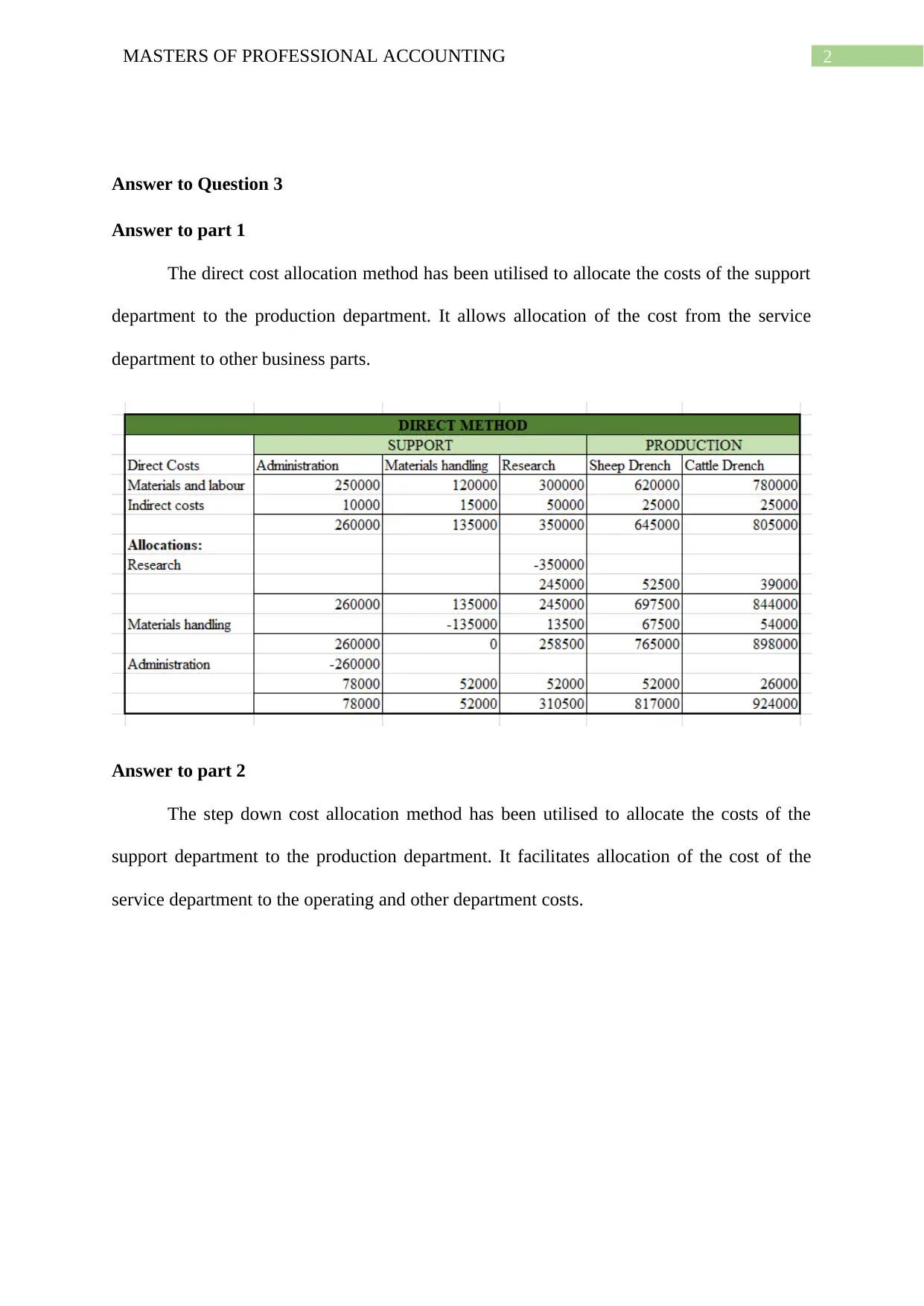
2MASTERS OF PROFESSIONAL ACCOUNTING
Answer to Question 3
Answer to part 1
The direct cost allocation method has been utilised to allocate the costs of the support
department to the production department. It allows allocation of the cost from the service
department to other business parts.
Answer to part 2
The step down cost allocation method has been utilised to allocate the costs of the
support department to the production department. It facilitates allocation of the cost of the
service department to the operating and other department costs.
Answer to Question 3
Answer to part 1
The direct cost allocation method has been utilised to allocate the costs of the support
department to the production department. It allows allocation of the cost from the service
department to other business parts.
Answer to part 2
The step down cost allocation method has been utilised to allocate the costs of the
support department to the production department. It facilitates allocation of the cost of the
service department to the operating and other department costs.
⊘ This is a preview!⊘
Do you want full access?
Subscribe today to unlock all pages.

Trusted by 1+ million students worldwide

3MASTERS OF PROFESSIONAL ACCOUNTING
Answer to part 3
The reciprocal cost allocation method has been utilised to allocate the costs of the
support department to the production department. It allows the consideration of
interdepartmental services for the cost allocation of service department.
Answer to Question 4
Answer to part 1
The estimated allocation rate of overhead for the Research department would be 13.02
Answer to part 3
The reciprocal cost allocation method has been utilised to allocate the costs of the
support department to the production department. It allows the consideration of
interdepartmental services for the cost allocation of service department.
Answer to Question 4
Answer to part 1
The estimated allocation rate of overhead for the Research department would be 13.02
Paraphrase This Document
Need a fresh take? Get an instant paraphrase of this document with our AI Paraphraser
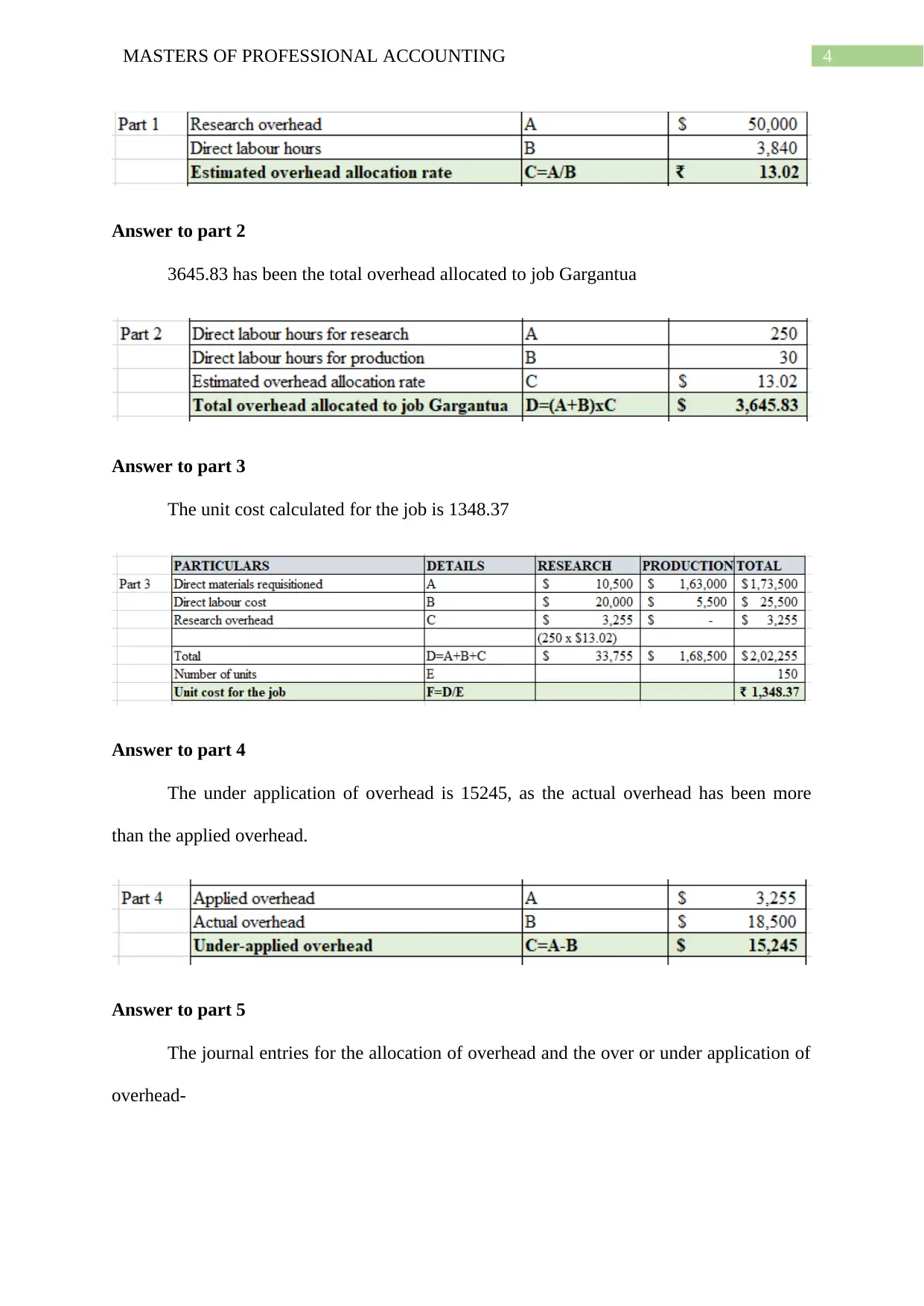
4MASTERS OF PROFESSIONAL ACCOUNTING
Answer to part 2
3645.83 has been the total overhead allocated to job Gargantua
Answer to part 3
The unit cost calculated for the job is 1348.37
Answer to part 4
The under application of overhead is 15245, as the actual overhead has been more
than the applied overhead.
Answer to part 5
The journal entries for the allocation of overhead and the over or under application of
overhead-
Answer to part 2
3645.83 has been the total overhead allocated to job Gargantua
Answer to part 3
The unit cost calculated for the job is 1348.37
Answer to part 4
The under application of overhead is 15245, as the actual overhead has been more
than the applied overhead.
Answer to part 5
The journal entries for the allocation of overhead and the over or under application of
overhead-
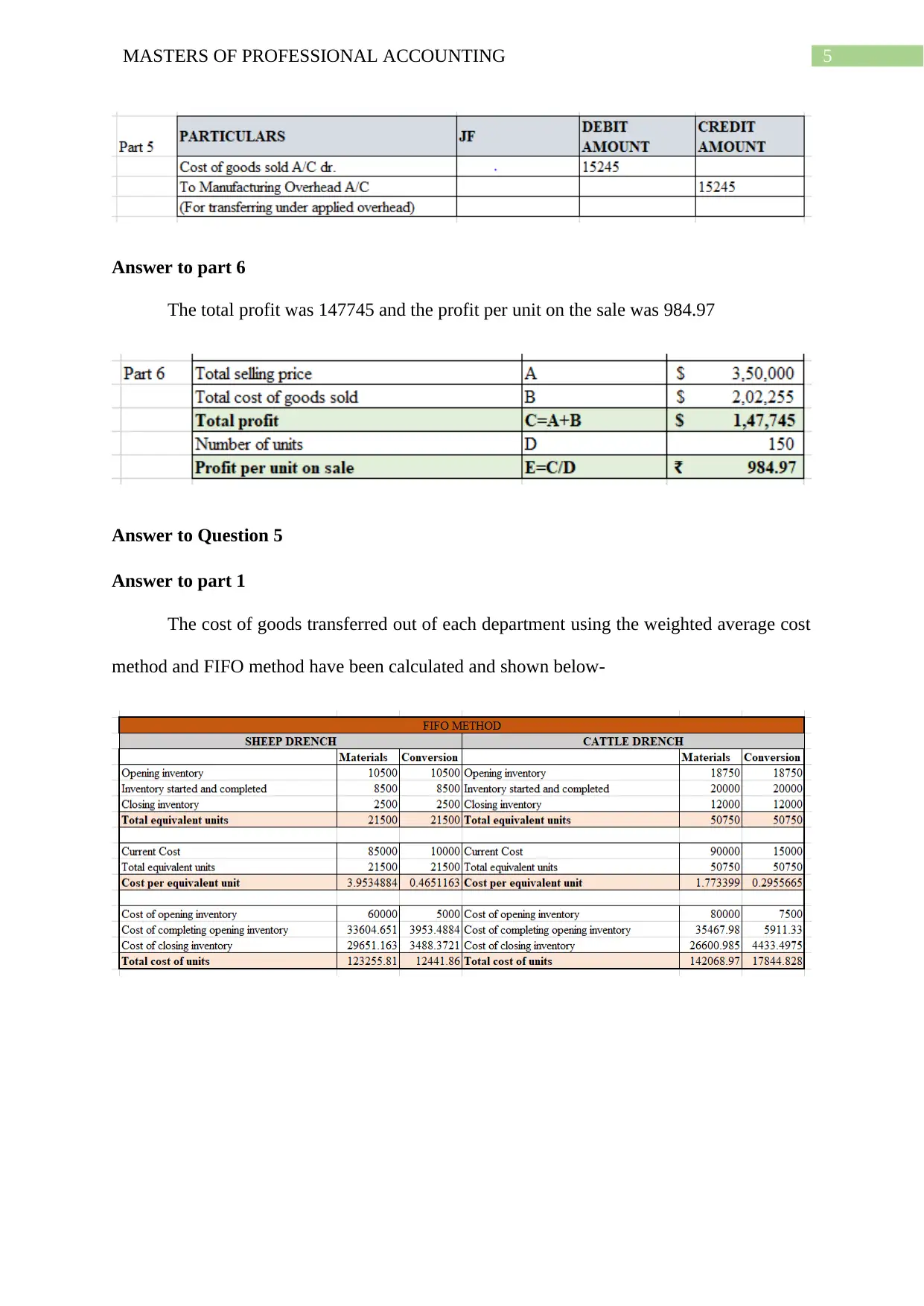
5MASTERS OF PROFESSIONAL ACCOUNTING
Answer to part 6
The total profit was 147745 and the profit per unit on the sale was 984.97
Answer to Question 5
Answer to part 1
The cost of goods transferred out of each department using the weighted average cost
method and FIFO method have been calculated and shown below-
Answer to part 6
The total profit was 147745 and the profit per unit on the sale was 984.97
Answer to Question 5
Answer to part 1
The cost of goods transferred out of each department using the weighted average cost
method and FIFO method have been calculated and shown below-
⊘ This is a preview!⊘
Do you want full access?
Subscribe today to unlock all pages.

Trusted by 1+ million students worldwide
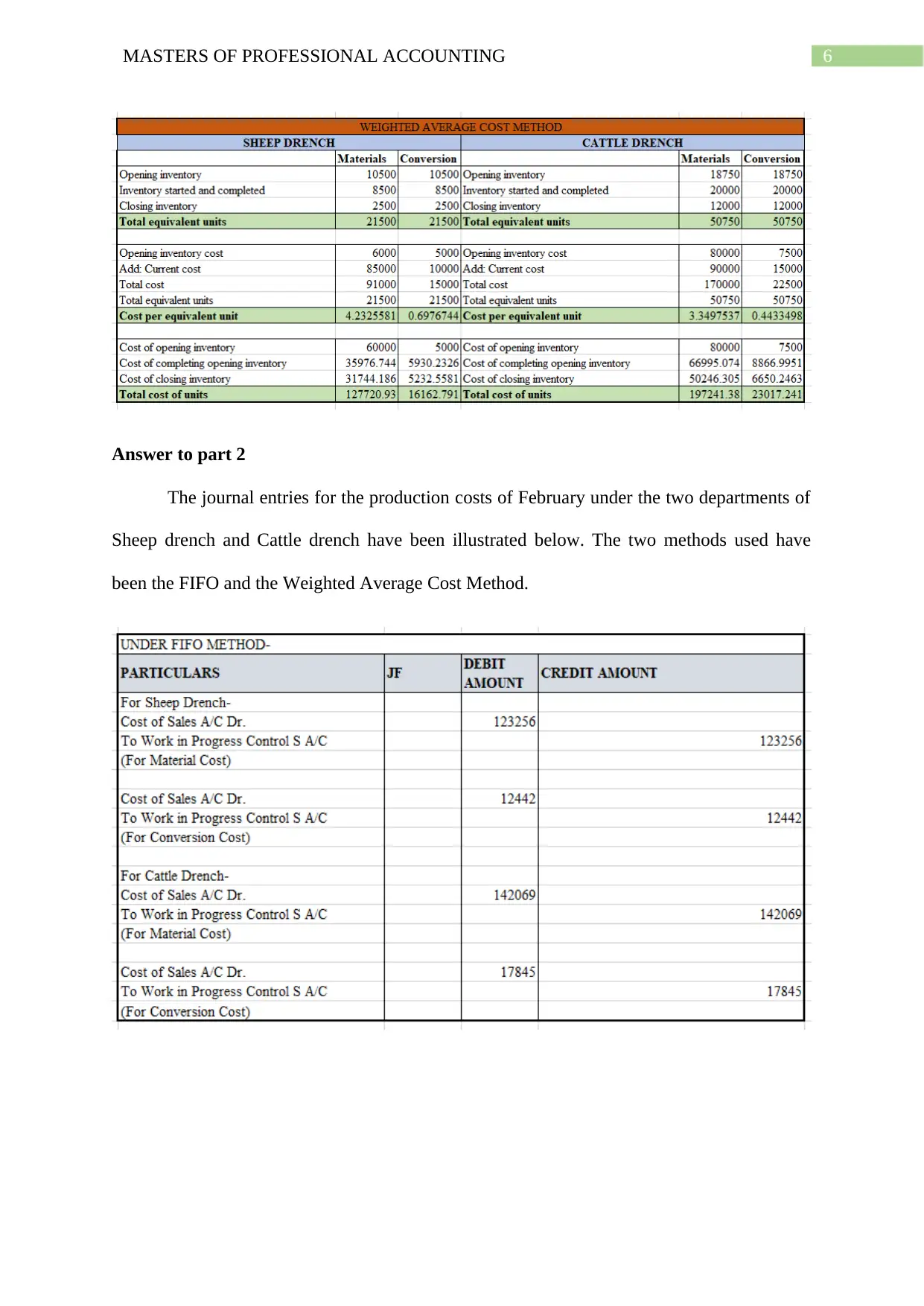
6MASTERS OF PROFESSIONAL ACCOUNTING
Answer to part 2
The journal entries for the production costs of February under the two departments of
Sheep drench and Cattle drench have been illustrated below. The two methods used have
been the FIFO and the Weighted Average Cost Method.
Answer to part 2
The journal entries for the production costs of February under the two departments of
Sheep drench and Cattle drench have been illustrated below. The two methods used have
been the FIFO and the Weighted Average Cost Method.
Paraphrase This Document
Need a fresh take? Get an instant paraphrase of this document with our AI Paraphraser
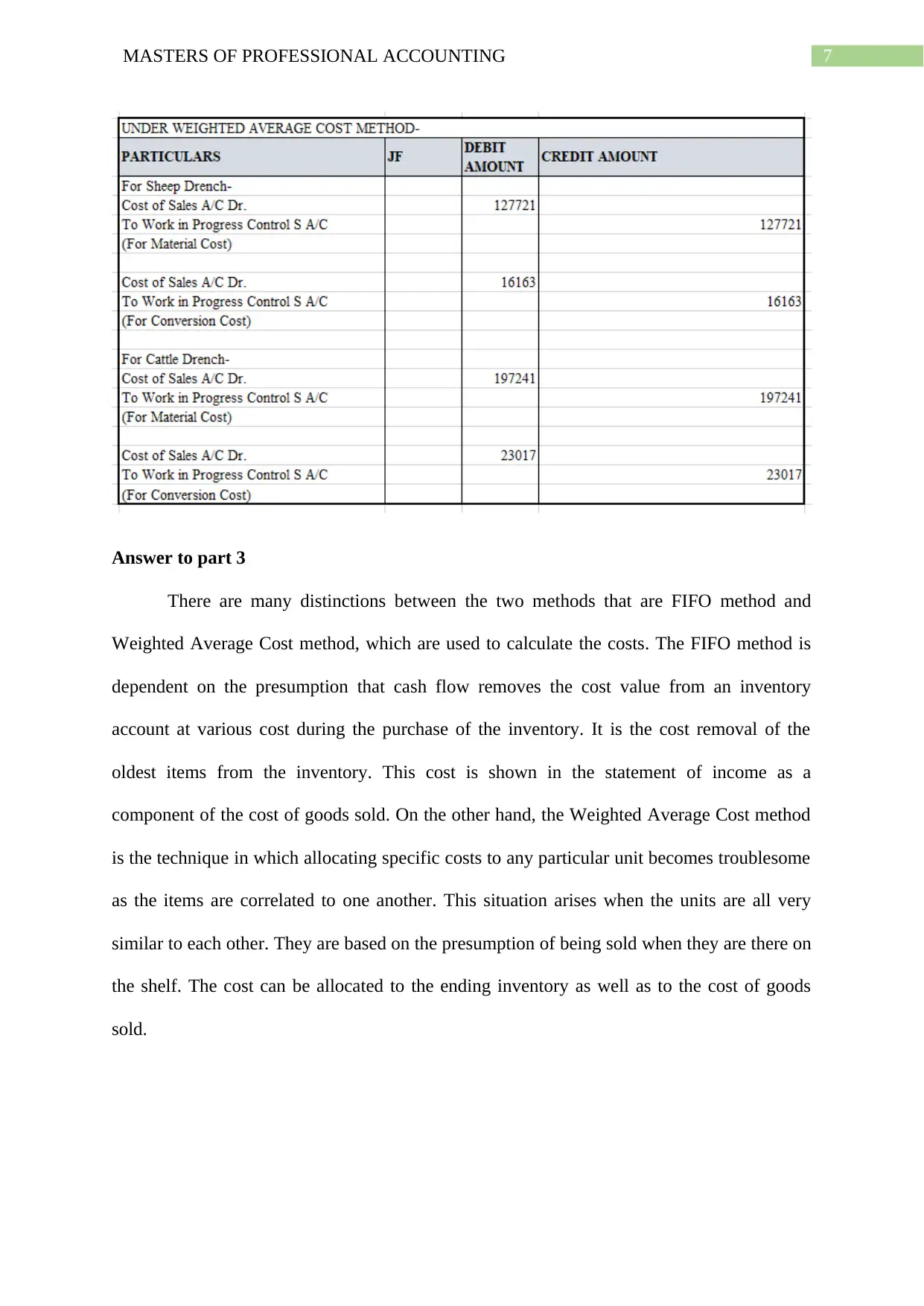
7MASTERS OF PROFESSIONAL ACCOUNTING
Answer to part 3
There are many distinctions between the two methods that are FIFO method and
Weighted Average Cost method, which are used to calculate the costs. The FIFO method is
dependent on the presumption that cash flow removes the cost value from an inventory
account at various cost during the purchase of the inventory. It is the cost removal of the
oldest items from the inventory. This cost is shown in the statement of income as a
component of the cost of goods sold. On the other hand, the Weighted Average Cost method
is the technique in which allocating specific costs to any particular unit becomes troublesome
as the items are correlated to one another. This situation arises when the units are all very
similar to each other. They are based on the presumption of being sold when they are there on
the shelf. The cost can be allocated to the ending inventory as well as to the cost of goods
sold.
Answer to part 3
There are many distinctions between the two methods that are FIFO method and
Weighted Average Cost method, which are used to calculate the costs. The FIFO method is
dependent on the presumption that cash flow removes the cost value from an inventory
account at various cost during the purchase of the inventory. It is the cost removal of the
oldest items from the inventory. This cost is shown in the statement of income as a
component of the cost of goods sold. On the other hand, the Weighted Average Cost method
is the technique in which allocating specific costs to any particular unit becomes troublesome
as the items are correlated to one another. This situation arises when the units are all very
similar to each other. They are based on the presumption of being sold when they are there on
the shelf. The cost can be allocated to the ending inventory as well as to the cost of goods
sold.

8MASTERS OF PROFESSIONAL ACCOUNTING
⊘ This is a preview!⊘
Do you want full access?
Subscribe today to unlock all pages.

Trusted by 1+ million students worldwide
1 out of 9
Related Documents
Your All-in-One AI-Powered Toolkit for Academic Success.
+13062052269
info@desklib.com
Available 24*7 on WhatsApp / Email
![[object Object]](/_next/static/media/star-bottom.7253800d.svg)
Unlock your academic potential
© 2024 | Zucol Services PVT LTD | All rights reserved.




